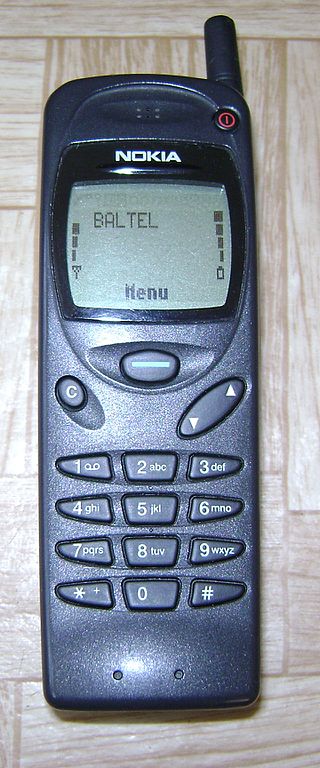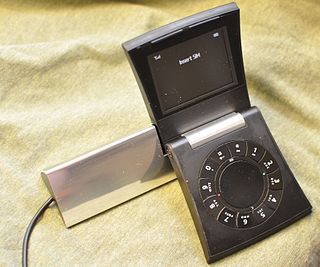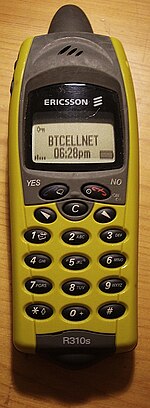
Telefonaktiebolaget LM Ericsson, commonly known as Ericsson, is a Swedish multinational networking and telecommunications company headquartered in Stockholm. The company sells infrastructure, software, and services in information and communications technology for telecommunications service providers and enterprises, including, among others, 3G, 4G, and 5G equipment, and Internet Protocol (IP) and optical transport systems. The company employs around 100,000 people and operates in more than 180 countries. Ericsson has over 57,000 granted patents.

The Global System for Mobile Communications (GSM) is a standard developed by the European Telecommunications Standards Institute (ETSI) to describe the protocols for second-generation (2G) digital cellular networks used by mobile devices such as mobile phones and tablets. GSM is also a trade mark owned by the GSM Association. GSM may also refer to the Full Rate voice codec.

NTT DoCoMo's i-mode is a mobile internet service popular in Japan. Unlike Wireless Application Protocols, i-mode encompasses a wider variety of internet standards, including web access, e-mail, and the packet-switched network that delivers the data. i-mode users also have access to other various services such as: sports results, weather forecasts, games, financial services, and ticket booking. Content is provided by specialised services, typically from the mobile carrier, which allows them to have tighter control over billing.
Sony Mobile Communications Inc. was a multinational telecommunications company founded on October 1, 2001, as a joint venture between Sony Corporation and Ericsson. It was originally incorporated as Sony Ericsson Mobile Communications, and headquartered in London, England, until Sony acquired Ericsson's share in the venture on February 16, 2012. On April 1, 2021, Sony integrated its electronics businesses including Sony Mobile into one company called Sony Corporation.
4G is the fourth generation of broadband cellular network technology, succeeding 3G and preceding 5G. A 4G system must provide capabilities defined by ITU in IMT Advanced. Potential and current applications include amended mobile web access, IP telephony, gaming services, high-definition mobile TV, video conferencing, and 3D television.

Kyocera Corporation is a Japanese multinational ceramics and electronics manufacturer headquartered in Kyoto, Japan. It was founded as Kyoto Ceramic Company, Limited in 1959 by Kazuo Inamori and renamed in 1982. It manufactures industrial ceramics, solar power generating systems, telecommunications equipment, office document imaging equipment, electronic components, semiconductor packages, cutting tools, and components for medical and dental implant systems.

The 3110 is a GSM mobile phone handset manufactured by Nokia in Hungary, introduced at CEBIT in March 1997. The 3110 is notable as the first Nokia handset to feature the 'Navi-Key' menu navigation system. The Navi-Key was featured heavily on Nokia handsets, especially the entry-level models such as the Nokia 1100 in the following years. Unlike its successor, the 3210, and subsequent handsets of similar design, the 3110 had an external antenna. The phone was available with a slim, standard or vibrating battery. It could only be used on a GSM-900 network.
Thuraya is a United Arab Emirates-based regional mobile-satellite service (MSS) provider. The company operates two geosynchronous satellites and provides telecommunications coverage in more than 161 countries in Europe, the Middle East, North, Central and East Africa, Asia and Australia. Thuraya's L-band network delivers voice and data services.
ACeS was a regional satellite telecommunications company based in Jakarta, Indonesia. It offered GSM-like satellite telephony services to Asian market. The coverage area included Indonesia, Malaysia, Thailand, Philippines, Sri Lanka, Vietnam, China and India. The company operated the Garuda 1 satellite, launched on February 12, 2000. A second satellite was planned but never materialized. ACeS was formed by a joint venture of PT. Pasifik Satelit Nusantara (PSN), Lockheed Martin Global Telecommunication (LMGT), Jasmine International Overseas Ltd of Thailand and Philippine Long Distance Telephone Co. (PLDT). ACeS services were marketed by National Service Providers (NSPs) in six countries; PT. Pasifik Satelit Nusantara in Indonesia, ACeS Regional Services in Thailand, Smart ACeS in the Philippines, TMTouch/Celcom in Malaysia, AVCO in Nepal and Mobitel in Sri Lanka.

Ericsson Mobile Platforms (EMP) was the name of a company within the Ericsson group that supplied mobile platforms, i.e. the technological basis on which a cellular phone product can be built. The main office was in Lund, Sweden.

Serene is a mobile phone produced as a joint venture between Samsung Electronics and Bang & Olufsen. It was released in the last quarter of 2005 in Europe. It was available in select stores throughout the world and cost $1275 (~€1000).

Martin Cooper is an American engineer. He is a pioneer in the wireless communications industry, especially in radio spectrum management, with eleven patents in the field.
Wireless Application Protocol (WAP) is a technical standard for accessing information over a mobile wireless network. A WAP browser is a web browser for mobile devices such as mobile phones that use the protocol. Introduced in 1999, WAP achieved some popularity in the early 2000s, but by the 2010s it had been largely superseded by more modern standards. Almost all modern handset internet browsers now fully support HTML, so they do not need to use WAP markup for web page compatibility, and therefore, most are no longer able to render and display pages written in WML, WAP's markup language.

The Nokia 2110 is a cellular phone made by the Finnish telecommunications firm Nokia, first announced in February 1993. It is the first Nokia phone with the famous Nokia tune ringtone. The phone can send and receive SMS messages; and lists ten dialed calls, ten received calls and ten missed calls. At the time of the phone's release, it was smaller than others of its price and had a bigger display, so it became very popular. It also features a "revolutionary" new user interface featuring with two dynamic softkeys, which would later lead to the development of the Navi-key on its successor, the Nokia 6110, as well as the Series 20 interface.
Samsung Mobile Division is one of five divisions within Samsung Electronics, belonging to the Samsung Group, and consists of the Mobile Communications Division, Telecommunication Systems Division, Computer Division, MP3 Business Team, Mobile Solution Centre, and Telecommunication R&D Centre. Telecommunication Business produces a full spectrum of products from mobiles and other mobile devices such as MP3 players and laptop computers to telecommunication network infrastructure. Headquarters is located in Suwon, South Korea.

The Ericsson R290 is a combined GSM and satellite phone using the Globalstar satellite network. The R290 was introduced in June 1999 and manufactured in the United Kingdom by Ericsson Mobile Communications.

In telecommunications, long-term evolution (LTE) is a standard for wireless broadband communication for mobile devices and data terminals, based on the GSM/EDGE and UMTS/HSPA standards. It improves on those standards' capacity and speed by using a different radio interface and core network improvements. LTE is the upgrade path for carriers with both GSM/UMTS networks and CDMA2000 networks. Because LTE frequencies and bands differ from country to country, only multi-band phones can use LTE in all countries where it is supported.

The Japanese mobile phone industry is one of the most advanced in the world. As of March, 2022 there were 199.99 million mobile contracts in Japan according to the Ministry of Internal Affairs and Communications. This is 158 percent of Japan's total population.

Ericsson Mobile Communications AB was a subsidiary of Ericsson, entirely focused on development of mobile phones (handsets). The major offices were located in Lund, Kumla, Raleigh, North Carolina and Lynchburg, Virginia.











